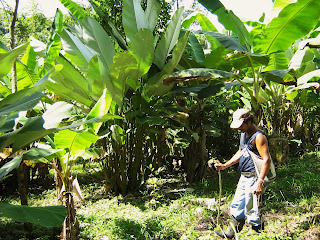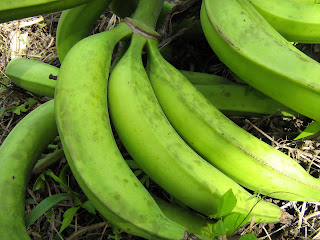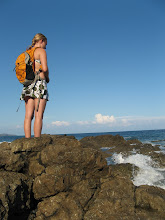
El Camino a la finca de Alvin ~ The hike to Alvin's farm
It was already 7:30am when Heidi, Alvin and I finished our strong cups of coffee and I had eaten my usual bowl of oatmeal. We grabbed our water bottles from the fridge, put our boots on and headed for the mountain. This morning we were hiking to Alvin’s farm to see what he had done with the land given to him by his father. We were promised to see beautiful vistas, platains, banana, avocado, orange, and lemon trees and an abundance of other plants. Alvin and his six brothers were each given a section of his father’s land to farm, however Alvin was given an extra hectare because he had spent more time working the land than any of his brothers. He is also the only brother that lives on his land.

Instead of walking the 30 minutes down the main road, we took our time hiking first through the back of Heidi’s property, then through two of her neighbor’s farms and eventually to Alvin’s little piece of paradise. A week ago, we three, along with four others, took a half day hike into the mountain. We saw snakes, lizards, turtles, frogs, birds, and hundreds of different types of insects; plants one could use to heal bruises, headaches, and sore throats; and several edible fruits and plants of which we collected and took home with us. I was familiar with the path we’d taken before and was curious and excited to see what path we’d take today.

Alvin has lived here in Londres for most of his life and helped his father tend their land. Heidi grew up on a farm in Germany and has lived in Costa Rica now for almost 18 years, the last 5 spent here in Londres. They are both a wealth of knowledge and as equally in awe of the nature that surrounds them. I hang on their every word most times, attempting to translate the information and save it in my memory.

As we walked today, again they point out the diversity of flora and fauna, looks under rocks and leaves for frogs, snakes, crab, and fish, all the while Alvin chopping our path through the dense rain forest with his recently sharpened machete. Always wanting a new adventure, a new vista, an un-trodden creek bed, Heidi makes sure that we take a different path than we had before. We climb steep hills and come upon incredible vistas that see as far as the Pacific Ocean. We stop and pick the fruit of one tree called Manzana de Agua, water apples. They were so sweet, soft,and extremely juicy. We grabbed about five apples each to take back home.

At one vista we could see the islands off the coast of Manuel Antonio. Below us, Alvin points out where each farm starts and another ends. He tells us a North American has just bought the land to the right of the winding river that runs through the middle of the valley. He wonders what will come of it; continue to be a valley of diverse crops and fruits trees…or a display of hotels for the tourists. “You never know these days,” he sighs.

We continue on, descending down the mountain side. We come to the fence, shove our backpacks and hiking sticks in front us and crawl under the barbed-wire property line. We are now in Alvin’s neighbors’ land. Millions upon millions of cicadas rub their wings together in the trees, creating a symphony of sound so profound that we three humans below find it hard to hear ourselves think. As we are taking a break in the shade, the owner of the land walks up and chats with us a bit. Alvin tells him we are taking a tour to his farm and the man says we can take the path on his land that will lead us down a beautiful creek, called a quebrada in Spanish, and right into Alvin’s property.

The path is behind this man’s home, a small house made of sheet metal and wood harvested from the ground it was built. His mother, an elderly woman of maybe 90 years old, stands barefoot outside to greet us. I was so drawn to this woman. She is probably only 4’7, covered in wrinkles, and wearing home sewn clothes. The white stitch stood out on her pink blouse and her apron was crooked. She said very little, only “Buenos Dias!” and “Adios”, but of all the things to look at around me, my eyes only see her. This small woman seemed to embody a quite, humble life. As we walk away she slowly reaches to the ground to collect kindling for the stove.
The path down to the creek is steep and dense. Trailing behind Alvin and Heidi, I turn to take one more look above us. The man I’d just met was standing at the top, silhouetted by his house and smiling.

I catch up with Heidi and Alvin and we cross the property line into Alvin’s land. We sit down in the cool shade to rest. Here Alvin explains the irony of owning land in Costa Rica. His neighbor, a man of maybe 60 years old, owns several acres of beautiful, plentiful land with a creek running through it and a beautiful view of the ocean, yet he lives a seemingly poor life. His house is not built with expensive materials, nor does he own a car, a horse, or any type of agricultural machinery; nevertheless, he is rich in land. Those who own land here in Costa Rica are not guaranteed that the produce that grows on their soil will have a market and bring them a steady income.
Heidi chimes in saying that it is true that this man may live a outwardly poor life, but it’s very possible that he does not want such riches. For some farmers, to be rich is to be able to walk a piece of beautiful, tranquil land and tend to the fruits of their labor; to be a part of nature and work with nature instead of against it. The farmers that make the most money here are those that work for the big companies. They must grow enough of one crop to make a sufficient profit. For example, if this man could make a great amount by clearing his land and planting only banana trees. He may profit monetarily by this decision, but he would also go against the natural biodiversity of the ecosystem. Without the assortment of fruits, flowers, and wood of all the mango, orange, lemon, avocado, cacao and plantain trees, the diversity of birds, butterflies, moths, bees, and other insects and animals will leave or die, having no habitat in which to live. Without the diversity of flora and fauna that give life and then decompose into the earth, the soil will be depleted of microorganism, nitrogen and other nutrients and the cyclical system that nature so perfectly creates will be broken.

Alvin’s father bought all his land about 40 years ago for less than $1 a hectare. One hectare equals 2.47 acres. Today, each hectare is a couple of thousand dollars each. Having been offered money to sell, his father has declined each time. I heard this same story from another farmer, Victor, last week at La Reserva de Los Campesinos, a cooperative of farmers that now run a eco-tourism business. Victor said he cannot put a monetary value on any inch of his land. He has been offered enough money for the land to live on very well for many years to come, but he has also declined each time. I have heard many unfortunate stories of poor farmers selling their land to foreigners who in turn build resorts or discontinue tending to the land with care. However, farmers like Alvin, his father, and Victor have resisted the temptations for such a profound wonder and respect for the land.

At Alvin's farm, he should us the pineapple plants, plantain, avocado and banana trees, and other various fruit trees.

Pinnaple plant

Sugar cane
He has cleared a small area to build a new home one day. On Alvin's only day off, he tends to his land, pruning, planting, and building his compost piles. The avocados will fruit in May and June, as will the several of the fruit trees, such as orange, lemon, and lime. There were plantains, though, and we filled our backpacks to the brim and continued our hike back to Heidi's farm.



This is a fungus growing on the limbs that a certain type of fly feeds on.
---------
On the return hike, we crossed terraced hills with fresh remnants of a cow's presence. Around 11:30am, the rain came...first as a mist, then a shower, and then it really began to pour. As I trailed behind Heidi and Alvin, these words ran through my mind over and over again:
See the elements,smell the elements,feel the elements...protect the elements.

During that 6 hours trek that crossed four different farms, I heard hundreds of fascinating facts and stories and am still attempting to remember them; however to simply be on the land, to see how the farmers have tended to it so carefully and intelligently, and to see, hear, and feel the elements is a priceless experience.
